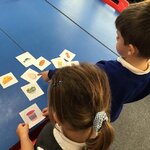Phonics (Letters & Sounds)
What is phonics?
Phonics is a method of teaching children to read. Phonics works by breaking words down into its individual sounds; there are 44 different sounds in the English language. Learning to read with phonics is therefore a bit like learning a code; after learning just a few sounds, you will be able to use this code to read hundreds of words. The more sounds you know, the more words you will be able to work out how to read.
How do we teach phonics at Bridge School?
At Bridge School we use a systematic synthetic phonics programme (SSP) called Little Wandle Letters and Sounds.
All children in Year R and 1 have a daily phonics session in which they will build upon their phonic knowledge and therefore become more confident in reading. If children fall behind in their learning they will have extra small group or even 1:1 sessions to ensure that they catch up.
How can parents support reading at home?
The best way that parents can support reading at home is by reading to and with their children daily. There are two types of reading book that your child will bring home:
The first will be a reading practice book - this book will be matched to your child's current reading level and it may appear that it is too easy for the child. Please do not worry if this is the case, children need to read the same book several times to develop comprehension and build their fluency. Re-reading the same book again can also help build confidence.
The second book will be a sharing book - this will very likely be a book that they are unable to read themselves but is designed to help them develop a love of reading and this book will be one that they have chosen to share at home. Discuss the pictures, enjoy the story, predict what might happen next, use different voices for the characters, explore the facts in a non-fiction book. The main thing is that you enjoy the book!
How do I use the Reading Record?
Each child will have a Reading Record and we will note when children have read to an adult in school and let you know if there is a specific aspect that your child needs to practice at home. We would also welcome parents commenting on other reading that takes place in the home such as sharing other books that they are reading for pleasure - make your comments as positive as possible to build your child's confidence.
Where can I find more information?
Little Wandle Letters and Sounds have a Parents Resource page where you can see videos explaining aspects of the programme and download guides to support your child at home.
Phonics Terminology
Alien words
A child-friendly term for ‘pseudo-words’, such as 'smork' or 'glub'.
Blend
To combine individual phonemes into a whole word, working all the way through from left to right.
Compound word
A word made by joining two individual words together, for example, ‘houseboat’ is ‘house’ + ‘boat’
Digraph
A grapheme using two letters to represent one phoneme. With children, we frequently reinforce it with the mantra ‘two letters, one sound’. At the appropriate stage, it is useful for children to learn to use the term and to understand what it means.
Grapheme
A letter or group of letters used to represent a particular phoneme when writing.
Phoneme
The smallest unit of sound that can be identified in words. We sometimes simply call this a ‘sound’, although it is helpful for children to use the term ‘phoneme’ from the beginning of our programme.
Segment
To identify each of the individual phonemes in a word, working all the way through from left to right. This is an important first stage of writing (spelling) a word but needs to be practised orally first
Split vowel digraph
A digraph representing a vowel sound where its two letters are split by an intervening consonant (for example, ‘a_e’ in ‘take’).
Tricky words
High-frequency words that, although decodable in themselves, cannot be decoded by children using the GPCs they have been taught up to that point.
Trigraph
A grapheme using three letters to represent one phoneme. With children, we frequently reinforce it with the mantra ‘three letters, one sound’.


